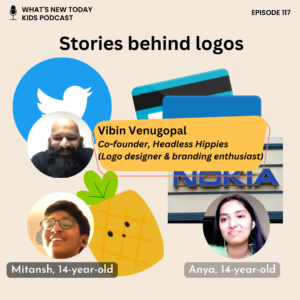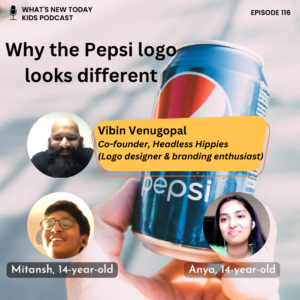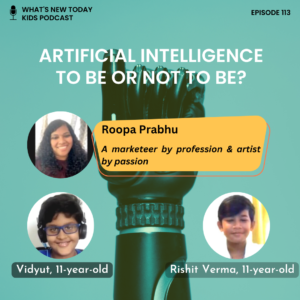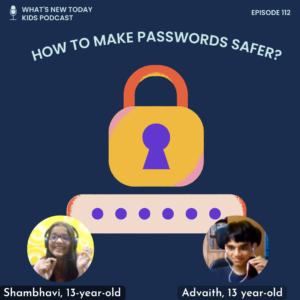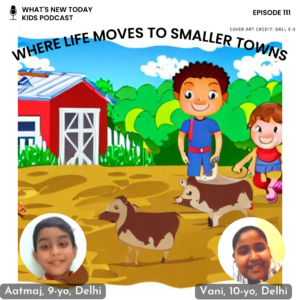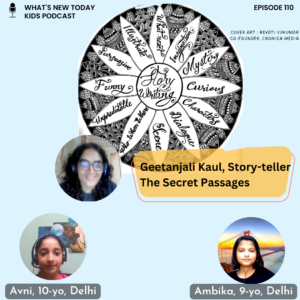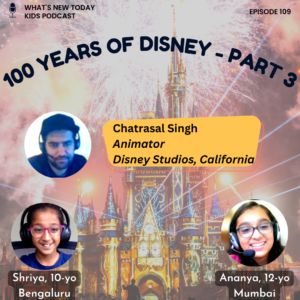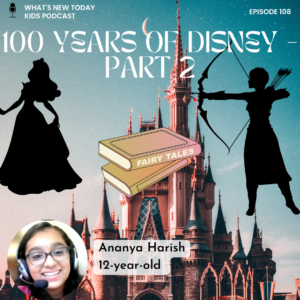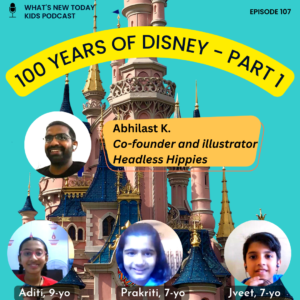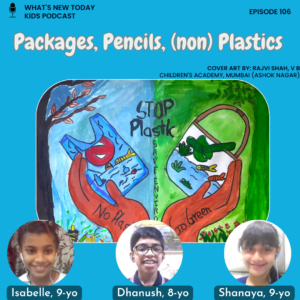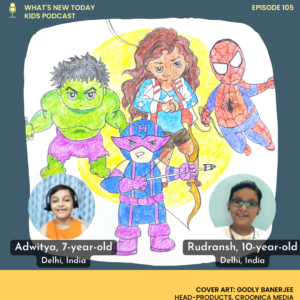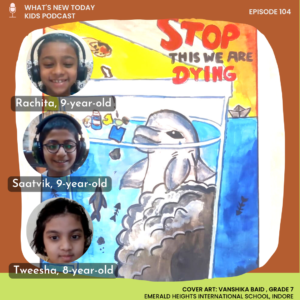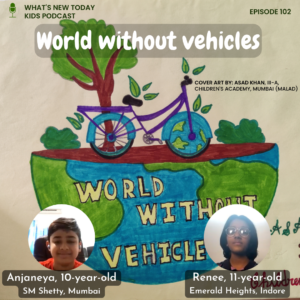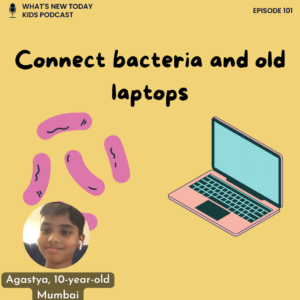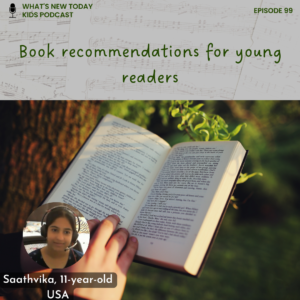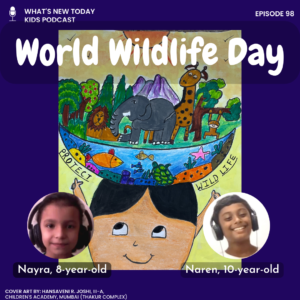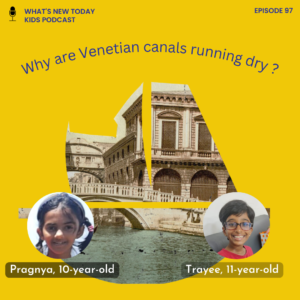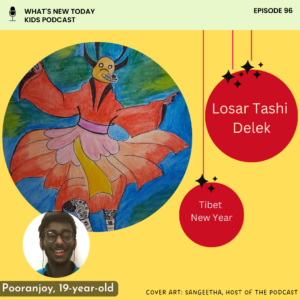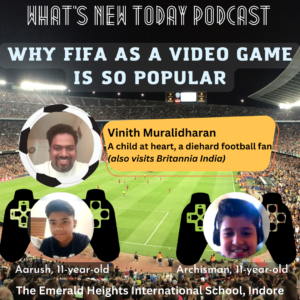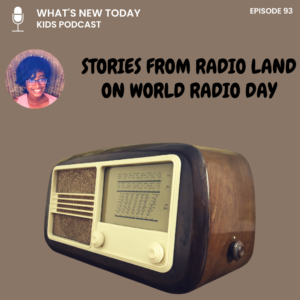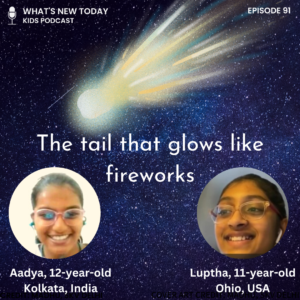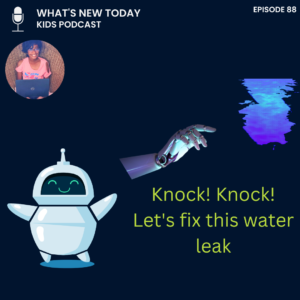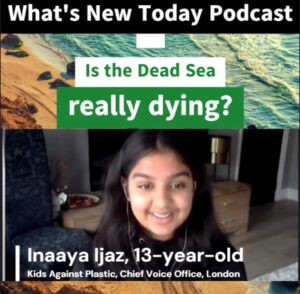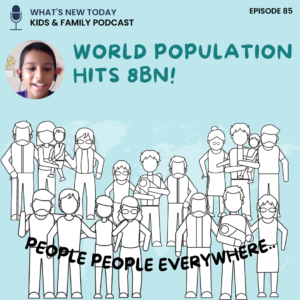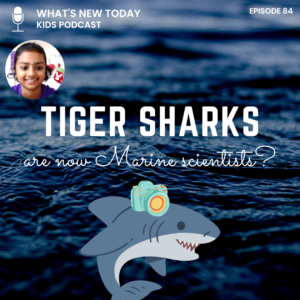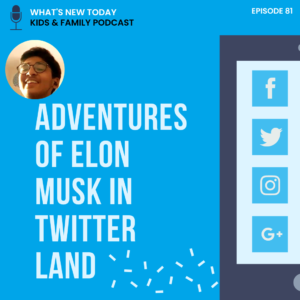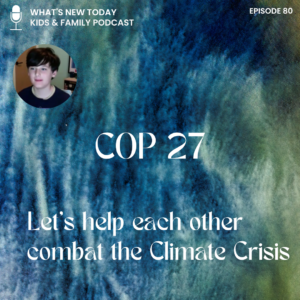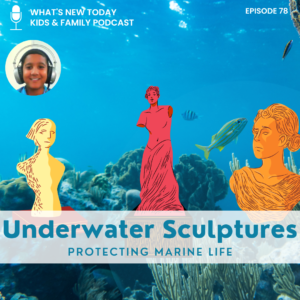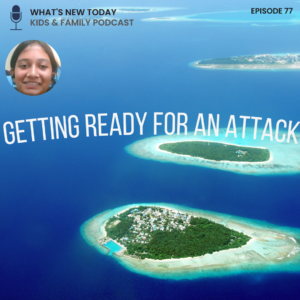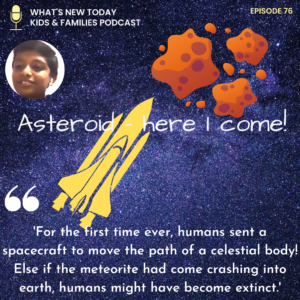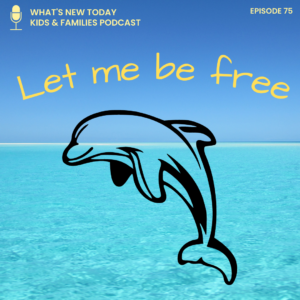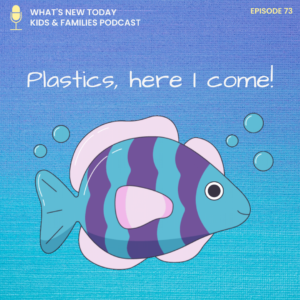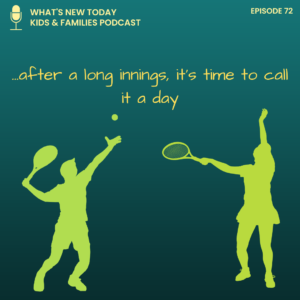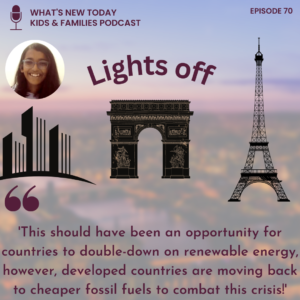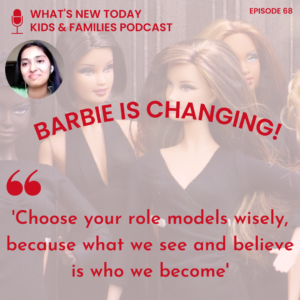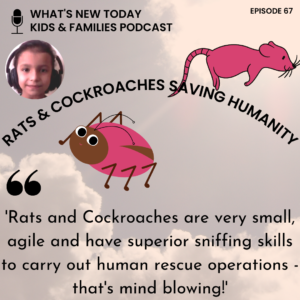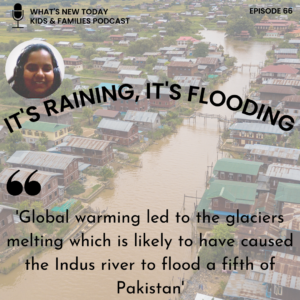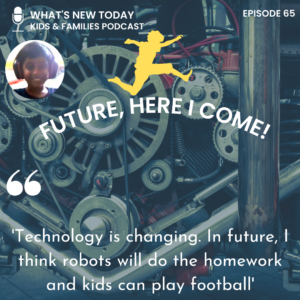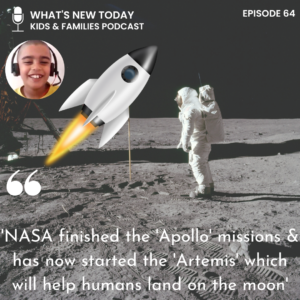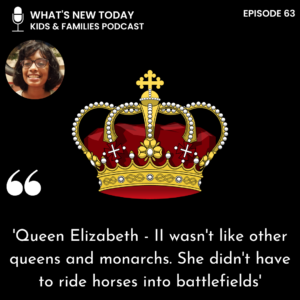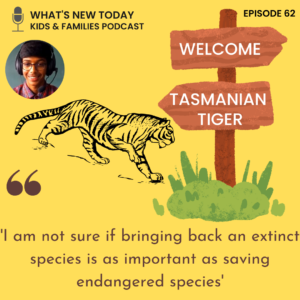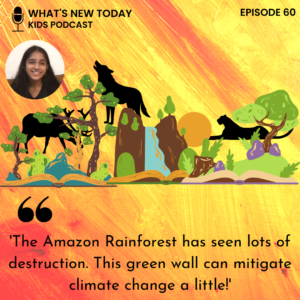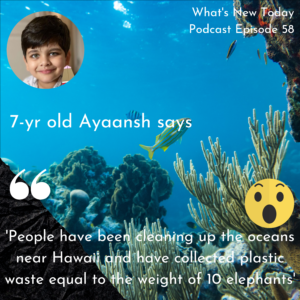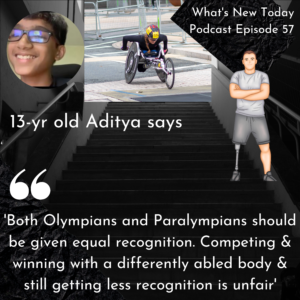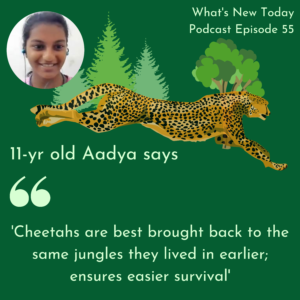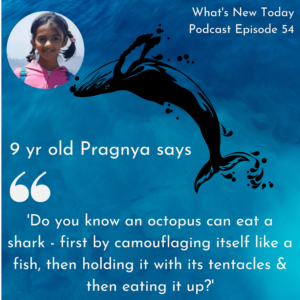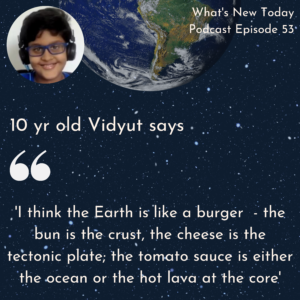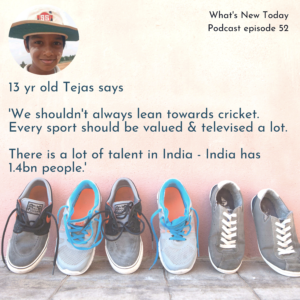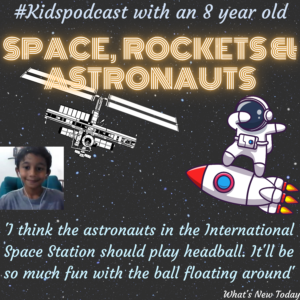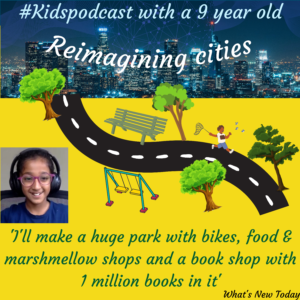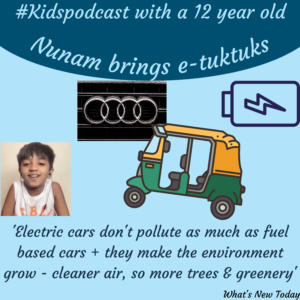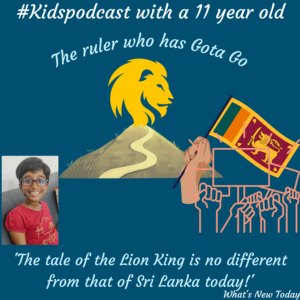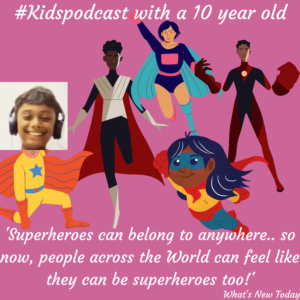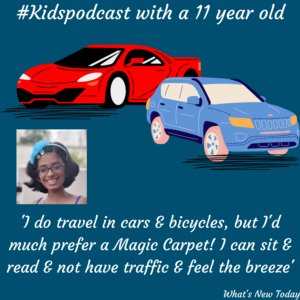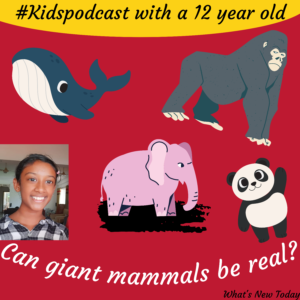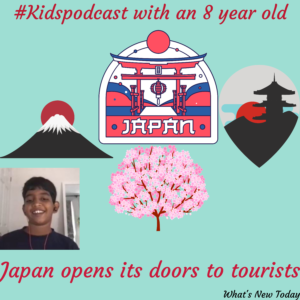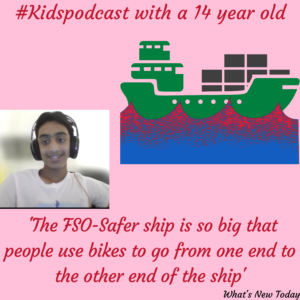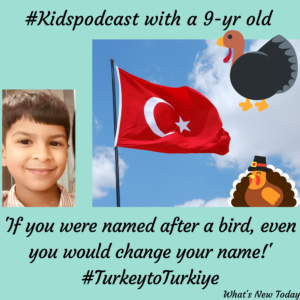Transcripts of our kids podcast
We research thoroughly for every podcast show. Enjoy the detailed show notes and reference links to journals
Ink and paper was all that we think of, when the printer comes to our mind.
But if we told you that you could order a cheesecake at the printer. Scientists at Columbia University recently introduced a 3D printing machine for children to choose which toppings and what flavours they would like on each cheesecake
With this, we sign off our 120th episode of Season 1. We will be taking a short break this summer and will come back with more stories about the real world around us, in season 2.
In this podcast episode, we dive into the fascinating world of artificial intelligence, exploring the distinctions between two powerful tools: ChatGPT and Google, and pondering the question of whether ChatGPT is poised to dominate the future.
Drawing from personal experiences, 11-year-old Vidyut and 12-year-old Rohan explore how from using YouTube to expand our understanding of art to leveraging Google Translate for help with Tamil homework, technology has seamlessly integrated into our lives.
Dive into the captivating world of AI in this thrilling episode, where we explore its fascinating potential and address the age-old question: should humans truly fear its rise?
Chirag Shetty and Satwiksairaj Rankireddy won the men’s doubles finals at Badminton Asia – the first pair from India to have won this in 58 years. We are familiar with Saina Nehwal and P.V.Sindhu – two Indians who made India proud by winning Olympic medals. Now Chirag and Satwiksairaj bring badminton once again into centrestage.
In this episode, 13-year old Eesha Vijay shares her thoughts on –
‘how does it feel when you watch professionals playing badminton on TV’
‘where did this game originate?’
Walt Disney used to take his children to neighbourhood parks. He felt disappointed with the kind of experiences these parks had to offer. He had grand ideas of building something more interesting. That’s how Disney theme parks came to be about. About this time, he had already started making animation movies. So combining the fairy tale characters he was showing in his movies with the fabulous theme parks he built, we get the logo of Disney – castle plus the words DISNEY.
Every logo has an interesting story to offer. In this episode (which is the second part of our series on Brands and Logos), 10th grader Mitansh Rajkotia and 11th grader Anya Chaturvedi, from Nagpur chat with Vibin Venugopal (co-founder of Headless Hippies, a brand and marketing consultant). They discuss many interesting stories about logos that have changed in recent times, including Nokia, Twitter and Frooti.
5 rings bring images of sports and victories in the Olympic. 4 rings shift our minds towards cars and the company Audi. A tick mark takes us to shoes and the company Nike. The letter G now represents the all-important Gmail.
Brands and logos are in front of us wherever we go. But why do companies change these, from time to time? Why does the company Pepsi keep changing the way its logo looks?
Listen to two teenagers Mitansh Rajkotia and Anya Chaturvedi and Vibin from Headless Hippies share stories about how these logos have come about.
Project Re-shark is an initiative to bring more sharks into our oceans. While some people have been busy over-fishing sharks, a few others have taken it upon themselves to grow baby sharks in aquariums and then releasing them back into the wild.
To talk about this interesting real life story, 7-year old Owen from New York (USA) joins us. While sharks are quite the thing that 7-year olds love to talk about, Owen also shares his opinions and ideas on –
a) Are sharks really dangerous to humans?
b) If he had a magic wand, which species would he save from going extinct?
No longer do you need to worry if your mobile phones are near or far from telecom towers. No longer do you need to think about whether you’ll get internet access when you are vacationing in some far off place, away from civilization, or up on a mountain or on a cruise ship far away from land.
In this episode, Syed Ayan, a fourth grader from Kuala Lampur, Malaysia, explains how all of this will soon come true. He will also explain the story of OneWeb – the company that has launched satellites into space, to bring us this connectivity.
Also, to help us make sense of how these satellites work, is a curious adult (and a child at heart) Aditya – who spends some part of his time tinkering with things at Texas Instruments and helps them do stuff that makes 4G and 5G work.
Together, Syed and Aditya piece the story of how OneWeb’s satellites that were recently launched by the Indian Space Agency ISRO, will help us access faster data speeds.
If there were a genie that said – name your wish and I’ll show you a picture of how your wishes or dreams would look, we seem to have found it.
It goes by the name ‘artificial intelligence for art’. In the past few months, many such engines generate art after you give them a prompt. You could go wild with your imagination and even ask for – ‘show me a picture of a lion sitting in an office typing out an email, with a unicorn munching a cracker next to it’.
How do these engines create such works of art in a matter of a few seconds?
Will this hurt the livelihoods of artists?
Listen to this incredibly quirky, introspective and quick-paced episode featuring 11-year old Rishit and Vidyut and Ms. Roopa Prabhu, who is a marketeer by the day and an artist by passion. You’ll find answers to these questions and more.
From email IDs to opening youtube accounts, passwords are some of the most common things we type, day in and day out.
In this episode, ninth-graders Shambhavi Nautiyal and Advaith Nair from Ahlcon Public School, Delhi, share their thoughts on how we can make passwords safer.
They also speaking of impending risks to our passwords from quantum computers.
If the word countryside and summer vacations reminds you of adventures of the Famous Five, children in Japan are being enticed to have just that – a lot of adventures by the village-side all year round!
Japan is facing extreme pressure in its tightly congested cities such as Tokyo. The government is encouraging families to move to smaller towns by the city. They hope that the monetary incentive will prove strong enough a motive for counter-urbanisation.
Will this really help?
Has any other country tried this?
You’ll find answers to these and more from Aatmaj and Vani – both primary schoolers from Ahlcon Public School, Delhi.
Roald Dahl used to visit the chocolate factories near his school, as a boy. The multiple machinations and the workers in the factory all appeared to be a part of a magical world. Years later, these experiences would inspire the popular work of ‘Charlie and the Chocolate Factory’.
In this episode, you can listen to Ms. Geetanjali Shetty Kaul, a professional storyteller who chats with primary schoolers Avni Prasad and Ambika Gupta from Ahlcon Public School, Delhi, about how to write creatively.
This is a 3-part podcast series, as Disney celebrates its 100 years of existence in 2023. This episode (which is part 3 of this series) an animator from Disney studios joins us.
Ever wondered how Mufasa’s road appears majestic? or how Rapunzel’s hair flows all around? or how Olaf jumps and hops around singing in the snow?
You can find answers to a ton of such questions in this episode. Chatrasal Singh, an animator with Disney Studios at Burbank, California, joins us. 10-year old Shriya from Bengaluru and 12-year old Ananya Harish from Mumbai quiz him on how he helps create Elsa or Mirabel on screen.
This is a 3-part podcast series, as Disney celebrates its 100 years of existence in 2023. This episode (which is part 2 of this series) covers the last couple of decades of Disney’s existence.
12-year old Ananya Harish from Bunt Sangha’s S.M.Shetty International School, Mumbai, India joins as the guest speaker in this episode.
After much reading about Disney characters (esp. Disney princesses), Ananya says she is pleasantly surprised by the personality trait changes in recent years.
‘How different are Disney princesses now, from the older ones like Snow White?’
‘How has Disney started picking up stories and characters from around the world’
‘What is the one Disney princess Ananya would like to see in the next movie?’
To find answers to these and more, listen to the full episode. We guarantee you a laugh, a ‘wow’ and great stories.
Disney studio was established in 1923. Rabbits, mice, ducks, cats and many more characters came alive on screen, thanks to Walt Disney and his team. Not happy with just showing his audience fairy tales on screen, Disney also expanded to develop theme parks. Now you could meet some of these characters in person and on rides, in these theme parks. As time went on, Disney studios brought bigger and richer folk tales from across the world (including stories such as Raya, the last Dragon).
In this episode, primary schoolers (Jveet from Children’s Academy, Prakriti and Aditi from Bunts Sangha’s S.M. Shetty International School & Jr. College, Mumbai) chat with a professional illustrator – Abhilash from Headless Hippies. You can hear stories from the early years of Walt Disney and how cartoon illustrations are made,
What’s flaxseed got to do with Lenovo?
What’s peanut shells got to do with food delivery?
What’s a pencil got to do with our terrace gardens?
The short answer is – packaging that is sustainable. In this episode, 9-year old Shanaya, 8-year old Dhanush and 9-year old Isabelle from the Children’s Academy Group of schools, talk about these stories. While we often talk about moving away from single-use plastics, this episode covers stories about companies that are making an effort to make this easier on us.
Lenovo’s laptop covers are made of flaxseed fibers. Many companies sell pencils with seeds in them. Food might be delivered via Swiggy and Dunzo in biodegradable covers soon.
Superheroes have captivated our imagination for eons. The Marvel Cinematic Universe – Spiderman, Doctor Strange and many more, has been one of the most successful superhero franchises. But a void has now arisen.
With Iron Man and Black Widow dead, Steve Rogers retired and Captain Marvel busy protecting other galaxies, the case for a new band of Young Avengers is high. In this episode, 7-year old Adwitya Goyal and 10-year old Rudransh Das from Children’s Academy group of schools, Mumbai, share their ideas on which five Young Avengers would work together best.
‘Do you think we can trust young children with superpowers?’
‘What superpowers do you think teachers would like to have?’
‘Who would make for a good leader for Young Avengers?’
Listen to the full episode to find answers to these questions and more.
In the story ‘Finding Nemo’, the journey undertaken by Marlin and Dory kept us all on the edge of our seats. Some of us may have also heaved a sigh of relief when the clownfish Nemo is saved and is back home. What if we told you that a band of humans have come together to save many more creatures of the sea, the ocean floor and much more. Yayy! It’s true.
Listen to 8-yr old Tweesha, 9-year old Saatvik and 9-year old Rachita – all of whom go to the Children’s Academy Group of Schools in Mumbai, India. The exuberance they feel at the idea of making life for marine creatures better, is abundantly palpable in their voices.
Cover art for this episode was made by a sixth-grader (Vanshika Baid) from Emerald Heights International School, Indore
In 64 years, for the first time, Dr.Nicola Fox, a British-origin scientist has been appointed to head science projects at NASA.
Her dad loved science and especially space, and some of that seemed to have rubbed off on her. She also went to a girls’ school and felt fully at home in science laboratories. There were no boys around, so no one told her that science may be for boys (mainly).
In this episode, discussing lots of stories about her childhood and school years, is a vivacious 11-year old Adya from India. Adya also shares research about some of the science projects that Dr.Fox has been heading and why 11-year olds like her, might find these fascinating.
Why did Dr.Nicola Fox decide to become a physicist?
Why are scientists such a curious bunch?
To find answers to these questions and more, listen to the full episode.
Imagine going on a holiday, where you can get around in only one of three ways – walking, riding a donkey or riding a bicycle. You would also have to carry your suitcases and bags around with no taxi to transport it around.
This would be true if you went to places like the island Hydra in Greece, the city of Ghent in Belgium and many islands in Maldives.
To talk about how interesting or difficult life would be in such islands, we are joined by Renee Agarwal from Emerald Heights International School, Indore and Anjaneya Navin from Bunt Sangha’s S M Shetty International School & Junio College, Mumbai.
Man will soon begin to build houses on moon. Check.
The James Webb Telescope might soon tell us how the universe began its journey. Check.
Bacteria can help us make new smartphones and laptop. Err…Not sure if we have lost our mind here?
Pinch yourself. This is reality.
In this episode with 10-year old Agastya Deshpande from Nahar International School, Mumbai, you will hear all about scientists who have discovered new uses for bacteria. They have the ability to accelerate the process of extracting metals.
Why do we need bacteria, you ask? The demand for phones and gadgets is only growing. We are in need of many rare earth minerals that are used in our devices. Bacteria will come in handy in extracting these from our old discarded gadgets.
What precious metals do our old phones have? To find out more, listen to epi 21 on how to responsibly discard e-waste
Our excitement at the prospect of having reached the 100th episode milestone must be palpable – in our voices, the podcast cover and even in our sound tracks 🙂
In this episode, 8-year old Devansh from Kolkata and 12-year old Eesha from Chennai (who have both appeared in previous episodes on science & wildlife stories) talk about their experiences. We answer questions such as –
‘Is there a script for each episode?’
‘How do the children prepare for each episode?’
‘How does the podcast channel maintain such a diverse set of topics’
You can listen to the banter between the host Sangeetha and Devansh & Eesha, as they try to answer questions from our listeners.
Love solving puzzles? Enjoy listening to mythological stories? You’re very likely to enjoy the two book series that our child co-host in this episode recommends.
11-year old Saathvika who goes to New Albany Elementary School from Columbus , Ohio (USA) shares her thoughts on two book series – the Aru Shah series and the Greystone Secrets series. Listen to her to find out what these two book series are about. She also has plenty of reflection questions – both for the host Sangeetha and our listeners –
‘Do you really think alternate dimensions exist?’
‘Has it ever happened to you that you think you have a good grip on something, but something else actually happens?’
Listen to the full episode to find answers to these and more.
Whether you are a bookworm yourself or an anxious parent trying to get your child to become a good reader, this episode gives you plenty of fodder about the new book series recommended.
A world where cameras do not just take pictures, but also tell you when and how to smile – is no longer the stuff of science fiction. For now, artificially intelligent cameras are already helping save the lives (and possibly the smiles) of people and endangered wildlife.
These AI cameras placed in multiple points throughout forests can alert forest rangers if any wild animals stray from their regular paths. Often times, these wild animals enter the habitats of humans, when they change their feeding paths. To prevent human-wildlife conflicts, these cameras are proving to be more than handy.
Listen to 8-year old Nayra and 10-year old Naren discuss how they think these cameras can improve the balance of wildlife inside forests. They also have interesting answers to questions such as –
‘What games do tortoises most likely play?’
‘What are the horns of rhinos made of?’
Long long ago, so long ago, that most people do know how long ago (because some people have read history textbooks), Venice was nothing more than a collection of marshlands. A few fishermen eeked their living by selling fish and making salt. In time, this group of islands became a place of refuge and grew into a large town.
10-year old Pragnya and 11-year old Trayee describe the history of Venice in a short story at the beginning of this episode. For those of us, the word Venice conjures images of tourists roaming around in gondolas. Not canals running dry and an unpleasant smell wafting through the air. If you happened to be visiting Venice this week, that’s exactly what you would have seen.
Why have these canals run dry?
Would a tourist in Venice have wasted their time this week?
How difficult is life for Venetians when there isn’t much water there?
Listen to the full episode to find answers to these and more.
Three days of festivities surround the lives of thousands of the Tibetan diaspora, as they welcome their new year – Losar. About the time when the winter chills dissipate and fresh harvest yields fill their granaries, the Tibetans (much like their Venetian friends) don masks and dance to ring in their new year.
In this episode, Puranjoy Bhattacharya, a student at the Sikkim Manipal Institute of Technology, shares his first-hand experiences of what it is like for an outsider to witness some of these gorgeous performances.
Puranjoy, who is a native of Assam, shares how different these cultures are, even though he himself has lived within the North Eastern belt all his life.
What do you a call yak who is full of himself?
Why don’t you find many Tibetans living in lower altitudes?
Listen to the full episode to find answers to these and more.
What do you do when older kids in your school don’t let you play striker and relegate you to defence?
You fight your way in the ground or pick up the FIFA video game and play whichever position you want to your heart’s content.
EA sports is parting ways with FIFA. The video game that millions of players are used to calling FIFA, will soon be renamed EA Sports FC. Getting used to that?
In these 2 episodes with Archisman and Aarush from Emerald Heights International school, Indore (both sixth graders), we are joined by Vinith Muralidharan – a child at heart, a diehard football fan who also visits the offices of Britannia to help them with their marketing efforts.
In this 2 part series you can hear them talk about their favourite clubs, how the video game has evolved and its features on the PC and the mobile phone. If you are one for football trivia, Vinith and the 2 kids won’t disappoint you 🙂
Radio was this device in many homes that held a place of awe and respect for decades. It brought into many households the first pieces of information of what was going on in the real world. It also made entertainment commonplace. Be it classical or popular music, families clustered around the radio, for wholesome entertainment a few decades ago.
Today is the World Radio Day and we trace some interesting stories along the way of radio’s evolution.
Did you know that Asian lions lead their pride whereas African lionesses often defend their pride and territory? A recent newspaper headlining ‘Capt. Shiva Chauhan is the first women army officer to be posted in the Siachen Glacier’ caught the attention of two super enthusiastic children from Delhi, who join us in this episode. They explore the news story, alongside their observations on how this moulds with what we see in the wildlife.
12 yr old Riya Mishra and 14 yr old Madhu Kumari, from SKV Aya Nagar, Delhi (a TFI assisted institution) share their personal experiences and observations. They also tell us what it’s like to grow up in a setting which does not allow many girls to set their goals high.
News Story Snapshot: Till recently, women who joined the armed forces in India were allowed short service commissions. A recent change in the Supreme Court’s ruling has enabled women to serve for longer, and therefore rise upto important positions and ranks within the Indian army.
Comets come and go about a dozen times in a year without much fanfare. But a green comet that’s flashing its pretty smile at us, is causing much celebration around the world. There are excellent reasons why each one of us should look into our night skies to say hello to this comet. To begin with, how often do you get to meet something that’s last met Neanderthals roaming the face of this earth.
In this episode with fifth grader Luptha from Ohio and seventh grader Aadya from Kolkata, we explore the story of this comet and its origins.
‘Why are people scared of comets?’, ‘Do comets really grow tails?’ and ‘Who uses telescopes for the most part?’ – you can find answers to these questions and more, in this fun and interesting conversation.
The Great Backyard Bird Count (GBBC) doesn’t come our way everyday. But birds do. If you love observing birds, or are curious about them, or even just love to paint or draw pictures of birds – here’s an event that you can be a part of. An event where the input of each one of us from around the world can help conserve bird species and populations.
One of the three organisations that puts together the GBBC is the Cornell Lab of Ornithology. The Project Leader of GBBC – Becca Rodomsky Bish joins us in this 2 part episode to chat about birds and this event. Also on this episode are 3 curious kids – 9-yr old Shravan from Singapore, 10-yr old Taanvi from the US and 11-yr old Adya from India. We also answer questions on how to participate in it. There are lots of curious questions about birds too, that we have tried to answer in this episode.
We are sure the questions and ideas of these 3 children will both add to your education and entertainment.
Listen to the episodes in full to find out more about this event and about how to participate in it.
The UK loses 3 billion litres of water every day through leaks in its underground water pipes. That’s a LOT of water. Enough to fill a few hundred Olympic size swimming pools. Imagine all the fun kids can have splashing in these pools? But no, all that water is lost!
But now, the UK plans to use tiny robots to keep crawling through these pipes all year round. These robots will fix leaks faster than any humans can. 11-year Trayee from India tells us a lot more about this news story that she found fascinating.
If you have found the answer to the riddle at the end of this episode, please email it to us at [email protected]. You might win a chance to feature in one of our upcoming episodes, just like Trayee and several other co-hosts on this channel.
The world has been abuzz with a secret new weapon that can turn every student’s essay into a worthy A+ piece of paper. This weapon can also turn every worst programmer’s nightmare into a dream. By generating lines of code with no bugs. It is also a weapon that has turned every teacher’s dream into a nightmare. Having to figure out if the essay was really written by their student of this secret weapon.
This is an episode on ChatGPT. The language processing AI tool that has taken the world by storm in the last few months. In this episode, we explore if ChatGPT is really worth its hype. You can get to experience real-time how ChatGPT responds to queries and answer the single most important question in life – can ChatGPT do all my homework?
The word Dead sea conjures images of people relaxing in the sea, floating with books in hand or just enjoying the starry images of the sky and the beaches around. But, if you plan on enjoying this anytime, you might need to make it there sooner rather than later.
In this episode, 13-year old Inaaya Ijaz, a climate activist from London, UK, talks about the Dead Sea and why it might be dying. There’s also trivia about Cleopatra, Egyptian mummies and ghosts from the Harry Potter books to keep you entertained, in this episode.
It has taken us a short 11 years from 2011 to 2022 to touch 8 billion people on this world. Babies are born all over the world. But if you did take a time machine into the future, you are most likely to see those babies born in Africa and Asia and emptier maternity hospitals in the western countries.
In this episode with 8-year old Jairam from Redwood Montessori School, Chennai, you will be fascinated by what a young curious child thinks of having more kids in his neighbourhood, of how we will have to create more spaces to live, and how happy old people are likely to be.
What does the grass lying on the bottom of the ocean have to do with the cars we drive? Here’s a trivia that will help you make the connection. The seagrass absorbs way more carbon than the tall trees on land. So, weep not, if you have been worried about the Amazon rainforests getting the axe. Help is at hand.
In this episode with 9-year old Ahalya Niranjan from Redwood Montessori School, Chennai, you can listen to the story about how some ingenious scientists use tiger sharks to help us map our ocean beds. Who better to help us locate seagrass than the creatures that spend hours a day scouring for food there. And what a cool way to use nature’s resources rather than having to invest in battery-operated submarines and cameras to roam the oceans. Listen to the full episode to find out more.
Children and adults love making creations – whether it is building sandcastles on the beach, or houses with cardboard boxes, or creating an Iron Man using Lego blocks. One teenager took up an interesting challenge – depicting the entire universe on a video game Minecraft. This was no frivolous pass-time. It involved making complex mathematical calculations and even sky-diving, to envisage how earth would look like, from space.
To discuss this achievement, 10-year old Abhir Ghalke from Bunts Sangha’s S.M. Shetty International School & Junior College, Mumbai joins us in this episode. He describes the myriad steps involved in building the solar system, galaxies and even black holes. Abhir, who is a bit of a space geek himself, has many trivia and jokes up his sleeve. Listen to the full episode to find out more and then attempt the below crossword puzzle to know your Minecraft understanding.
If you have pondered ways of testing your smarts against a computer, a game of chess will likely pop into your head. But some scientists decided to make things fun. They decided to use a 1970s video game called Pong, to test some real smarts. Think black and white screen, a paddle moving up and down, and a ball that bounces off the sides of the screen. Sounds odd? I mean, in this day and age, why not use an Xbox right?
Here’s the real clincher. The scientists did NOT test a real person’s brain, while playing this. But they used a brain that has been grown in a petri dish. Vedanshi, a 10-year old from Bunts Sangha’s S.M. Shetty International School & Junior College, Mumbai, explains this piece of science-fiction in simple and easy terms. Listen to the full episode to understand how this brain (a little less smart than that of a cockroach) has mastered the art of playing Pong – all by itself.
Vedanshi does a real cool job of explaining artificial intelligence of an artificial brain.
The world’s richest man wants to let everyone have an equal say in the world. He wants everyone to share their ideas – no matter if they are Thanos or one of the Avengers. Elon Musk went ahead and bought a company Twitter to allow just that – all for all. No half measures.
In this episode, Mitansh from DPS Nagpur discusses the dash of ‘spices’ that Elon Musk has brought along. Rocked by a lot of loans to be paid off, Musk has begun firing most of the staff. Mitansh describes what he thinks of this maverick entrepreneur and his opinions about whether Twitter will likely survive.
Planet Earth is getting warmer. Some leaders meet every year to talk about what they can do to combat climate change. Few countries go home and do something to reduce their emissions. In the midst of all this rather gloomy news is another interesting twist – although poor countries have hardly emitted any greenhouse gases, they are facing storms and floods. Some island nations could be at the brink of being submerged forever. Take a moment and think about this – these countries caused little or no carbon emissions in the past. But they are facing extreme weather events. Is this fair?
In this episode, 11-year old Zachary from California shares his thoughts about how the developed world owes the developing world. Zach believes rich countries need to help the poor countries rebuild their nations after such extreme climate events. He also walks us through some of the simple things that you and I can do, in terms of identifying the right items to recycle and segregate waste responsibly. Do you have any ideas of your own, on the topic of climate change or waste recycling? We’d love to hear them at [email protected]
The war in Ukraine took several unexpected turns, first with the Ukrainian defence of its capital Kiev and the united support of several Western countries. 13-year old Neil from G.D.Goenka School, Lucknow, who has taken a keen interest in tracking the events of the Ukraine war, walks us through initial attack by Russia. He also explains the kind of support that the US and other countries lent Ukraine to help it fend off the attacks by Russia.
Also joining us in this episode is 11-year old Trayee who speaks about how space-technology has played a much more key role in this war, than it has in any other war in the recent years. She speaks about how initial images captured by military satellites warned Ukraine of the impending attack. She also outlines how commercial satellites owned by Elon Musk helped Ukraine get its information and communication, up and running real quick. You can also find out more about how GPS has played a key role in guiding missiles.
Paolo Fanciulli, a fisherman who lives in Italy was always fascinated by shipwrecks and the fish and the algae that grew in them. He noticed also how it was getting harder to get any fish while casting his fishing nets thanks to trawling by large fishing companies. He noticed that nobody really cared about how these trawling nets were destroying the marine ecosystem. Apart from catching fish, they also caught a lot of the posidonia (or seagrass) which helped form nests for lobsters, sea bream and red gurnards to lay their eggs.
In this episode, 10-year old Azlaan from Army Public School, Barackpore, India talks about a creative solution that Paolo Fanciulli came up with. He decided to drop a few concrete blocks into the ocean. Next up, he wondered, after all – I live in Italy, the centre of art. So he got some sculptors to carve beautiful giant pieces and dropped these into the ocean as well. These works of art prevented trawling by ripping the nets apart, if they tried scraping the seafloor near the sculptures.
Azlaan explains how these sculptures not only stop illegal trawling but also help this part of the ocean become a tourist attraction. Tourists could dive and see the beautiful corals and fishes that form on these sculptures and swim around this museum. If given a chance, Azlaan would like to add a spiderman sculpture to this museum. Listen to this episode fully to find out more about the story.
The island of Taiwan which is 100 miles away from China is key for us to create this podcast and for you to listen to it. In case you are wondering, the host of this podcast does not live there. But our recording equipments, our editing tools and the device on which you are now listening to this podcast – are most likely made with one important part called the semi-conductor chip. Taiwan is the single largest manufacturer of these chips. If Taiwanese decide to take off and go on a long holiday, people around the world would be left staring at their Amazon orders showing a delivery date of 6 months from now.
In this episode, 15-year old Suyanshi from GD Goenka School, Lucknow explains how Taiwan became so important for our lives. She describes the history of the settlers in Taiwan and why China thinks it is simply a breakaway province. She also walks us through why Taiwanese engineers moved back to their island to build one of the most powerful industries in the world.
If you remember the tales about why dinosaurs went extinct, one of the common stories is that a meteorite crashed into earth. Some scientists in NASA who were thinking about this story were curious to see if we could avoid such a fate, if a meteorite came crashing into earth. And humans might become extinct. In this episode, 10-year Arav from Emerald Heights school, Indore, describes NASA’s daring mission into space.
For the first time ever, humans sent a spacecraft to move the path of a celestial body. The celestial body was an asteroid called Dimorphus. The spacecraft was called the DART mission. This spacecraft, which was the size of a giant refrigerator flying into space with two light sabres coming out of it, rammed into the asteroid. And yippee! the mission was a success. The asteroid’s path was changed.
Before you ask, this asteroid posed NO threat to earth. This was just a simple experiment to find if spacecrafts could change the orbit of asteroids. So, we can be prepared for an actual collision course reaction.
More than 50 years ago, an orca whale called Lolita was captured from the Pacific Ocean, when she was swimming alongside her mother and 6 siblings. Lolita has since then had to live in a tiny water tank in Miami and has been entertaining thousands of tourists. But now, the fate of many such marine animals is all set to change. Hollywood animatronic makers and marine biologists have worked on creating a really cool set of robotic dolphins. 10-year olf Taanvi from Ohio, USA speaks about this innovation that is all set to change the world.
Animatronic dolphins are made from scratch by a set of artists who first sketch the creature. Then, they create a mould of the creature – much the same way we make a gingerbread man with playdoh. And then, they break each part separately and insert electronic chips in each part so that it can be made to behave the way we want each part to. These dolphins are currently being made by a company called Edge Innovtions in New Zealand and a few amusement parks in China have already started using them. Yippee! To a free and carefree world for our marine animals!
This is Part 2 of the Nobel Prize winners for 2022. If you would like to listen to the super-fun stories in Part 1, please click here to listen to episode 69.
The winners for Chemistry, according to 10-year old Vidyut might open the doors for curing diseases such as cancer. As Vidyut explains, these laureates have discovered something called click chemistry, which is a lot like letting two lego blocks click together.
The winners for Economics, as 11-yr old Adya explains, might keep our money in the banks safer. And also in the event of a big problem, or an economic crisis, the governments would fund the banks to stop the crises from going on and on, or atleast longer than 3-4 years.
The winner for Literature, as 10 yr old Yoshika explains, is an inspiration for anyone to be honest and authentic about their writings. Autobiographical non-fiction genre of writing has received a big boost from this year’s winner – Annie Ernaux.
Remote controlled cars and planes are toys we are familiar with. A remote-controlled fish that can not just swim, but also eat the plastic pieces floating in the water is now around. Chinese scientists from Sichuan University have developed this little piece of marvel, in a bid to keep our oceans clean. 10-year Anura from Emerald Heights School, Indore, describes how micro-plastics is a big problem both for our fishes and for land animals.
More than 80% of us have micro-plastics in our blood. Ouch! How did we start eating plastics? Anura discusses some ways of how we get it into our foods and beverages. (a) Drinking tea from a tea bag releases more than a few billion micro-plastics into our tea. Oh! we’ll remember to make our tea the old fashioned way – boil some water and let our tea leaves steep in them. (b) Sea-salt can also carry micro-plastics given the large amount of plastics already absorbed by the sea-water.
This robotic fish from China can now start swimming in our oceans and eat up the plastics in the water. If a shark were to swim by and accidentally consume this robot, Anura assures us that the shark won’t get a stomach ache, since the robotic fish is made of a material that is eco-friendly.
Serena Williams and Roger Federer are synonymous with tennis. Both of them have dominated the sport, with a trail of Grand Slam titles and plenty of tennis records shattered. In this episode, 13-year Amogh from Michigan, a teen fond of playing both tennis and golf, walks us through the careers of these two tennis stars. Serena showed incredible promise as a sportsperson even when she was just a toddler. Her father Richard Williams is credited with coaching her in the early years. Federer, on the other hand, dabbled across a few sports, including tennis and did not become very serious about the sport until he was nearly 12.
When Serena won her first Grand Slam, she was only the second ever African-American woman to win one. When Federer won his first Grand Slam, he was the first ever Swiss male to win one. Both were sources of inspiration to their respective communities.
For instance, some countries in Europe are banning caged hens, some others are banning fur farming. Amsterdam will no longer allow customers in restaurants to boil lobsters alive and consume them. All a mark of our recognition that animals feel emotions – including depression, anger, pain or even excitement.
For instance, some countries in Europe are banning caged hens, some others are banning fur farming. Amsterdam will no longer allow customers in restaurants to boil lobsters alive and consume them. All a mark of our recognition that animals feel emotions – including depression, anger, pain or even excitement.
When Alfred Nobel read his obituary (much to his surprise), he was horrified to read its contents. His invention (the dynamite) had caused much destruction in the world. The newspapers wrote unflattering remarks about his achievements. Much affected by what he read about himself, Nobel set upon working towards bequeathing his wealth to achievers in different fields, who have helped mankind make great progress. This year was no exception. A distinguished set of people and organisations won the 6 prestigious Nobel prizes awarded in 2022 (October is when they announce the winners annually).In this episode, 12-year old Eesha, 10-year old Naren and 11-year old Trayee speaking about the winners in Physics, Medicine and Peace. In Physics, Eesha explains how particles sitting on different ends of the cosmos might still be able to communicate (faster than light?). This quantum entanglement has won the prize in Physics. Naren speaks about how new techniques to sequence the DNA of Neanderthals can help us understand how we (you and I included) have evolved. Trayee speaks about the stellar work that human rights activists in Belarus, Russia and Ukraine have accomplished tirelessly.
When Alfred Nobel read his obituary (much to his surprise), he was horrified to read its contents. His invention (the dynamite) had caused much destruction in the world. The newspapers wrote unflattering remarks about his achievements. Much affected by what he read about himself, Nobel set upon working towards bequeathing his wealth to achievers in different fields, who have helped mankind make great progress. This year was no exception. A distinguished set of people and organisations won the 6 prestigious Nobel prizes awarded in 2022 (October is when they announce the winners annually).In this episode, 12-year old Eesha, 10-year old Naren and 11-year old Trayee speaking about the winners in Physics, Medicine and Peace. In Physics, Eesha explains how particles sitting on different ends of the cosmos might still be able to communicate (faster than light?). This quantum entanglement has won the prize in Physics. Naren speaks about how new techniques to sequence the DNA of Neanderthals can help us understand how we (you and I included) have evolved. Trayee speaks about the stellar work that human rights activists in Belarus, Russia and Ukraine have accomplished tirelessly.
Barbie has long held a unique place and symbolised pretty looks. Not anymore. The company Mattel which makes Barbie dolls has pivoted towards showing Barbie dolls with a stronger personality. Barbie dolls are no longer just pretty faces with fancy shoes and bags. They also represent women with a purpose, profession and positive perspective. In this episode, 10th grader Anya Chaturvedi from DPS Nagpur speaks eloquently about Mattel’s pivot in its line-up of Barbie dolls.Mattel, in a survey, found that most mothers were concerned about the lack of positive role models in their children’s toys. This was a catalyst for a change in Barbie’s new introductions. You can now find a Barbie who looks like Amelia Earhart (the first female aviator to fly solo across the Atlantic), Jane Goodall (a primatologist) and Ashley Graham (a supermodel who is plus-size). Mattel hopes that these Barbie models will inspire girls to pursue sports or science and not merely just grow up with shopping and cooking on their agenda
Barbie has long held a unique place and symbolised pretty looks. Not anymore. The company Mattel which makes Barbie dolls has pivoted towards showing Barbie dolls with a stronger personality. Barbie dolls are no longer just pretty faces with fancy shoes and bags. They also represent women with a purpose, profession and positive perspective. In this episode, 10th grader Anya Chaturvedi from DPS Nagpur speaks eloquently about Mattel’s pivot in its line-up of Barbie dolls.Mattel, in a survey, found that most mothers were concerned about the lack of positive role models in their children’s toys. This was a catalyst for a change in Barbie’s new introductions. You can now find a Barbie who looks like Amelia Earhart (the first female aviator to fly solo across the Atlantic), Jane Goodall (a primatologist) and Ashley Graham (a supermodel who is plus-size). Mattel hopes that these Barbie models will inspire girls to pursue sports or science and not merely just grow up with shopping and cooking on their agenda
If this sounds like a piece of science fiction, our 8-year old co-host Nayra assures us that she has read plenty of articles and watched videos showing how this works. In the real world. Nayra also speaks about another creation (or more of an alternate training) to rats. Hero rats have been trained to sniff out landmines, and clean large tracts of lands, thus making them safe for people to use these lands without fear.
Most of us have played with a remote-controlled car that we like to guide across several surfaces – both inside and outside our homes. It appears that the child in us (who loves such remote controlled cars) never left the minds of some Japanese scientists. Recently, they created a cyborg cockroach. Its movements are controlled remotely by scientists. They guide it to crawl under the debris and rubble of earthquakes. The camera attached to this cockroach can help people identify any humans who are trapped and are in need of urgent rescue.
If this sounds like a piece of science fiction, our 8-year old co-host Nayra assures us that she has read plenty of articles and watched videos showing how this works. In the real world. Nayra also speaks about another creation (or more of an alternate training) to rats. Hero rats have been trained to sniff out landmines, and clean large tracts of lands, thus making them safe for people to use these lands without fear.
Why glaciers are melting in the Himalayas and rivers are flooding Pakistan
From faraway in space, if an alien happened to use a pair of binoculars, he might have easily mistaken Pakistan for a large river, or a bunch islands sticking out an inland sea. Certainly not for one of the most fertile lands growing fragrant and aromatic spices and rice.More than a fifth of Pakistan is underwater and is witness to one of the largest natural catastrophes. Sadly Pakistan maybe paying the price of global warming despite contributing to less than 1% of global greenhouse emissions. 11-year old Pritika Mathur thinks this is unfair. Developed countries have benefited from industrial development and left developing countries to bear the brunt of the impact. The third pole, as this region of the Himalayas is called, contains the largest collection of glaciers and ice, outside of the North and South Pole. Through a combination of glaciers melting and excess rainfall, the people of rural Pakistan (especially farmers) have lost most of their land, crops and livestock to floods, not seen in centuries
The father of science fiction and how he shaped modern Marvel and Geronimo Stilton works
In this episode, a 11-year old bookworm – Vedant from Singapore, explains why he think H.G.Wells wrote some of his bizarre science fiction stories, and about the author’s socialist ideals.Vedant also tries to look into the future and speaks of what he would like to see. ‘Would children really have to do their homework by themselves?”Does anyone go to school, in Vedant’s version of the future’You can find answers to these questions and more in this episode. A science fiction story plot has been given by Vedant in this episode.
Space News - Are we really going to the moon on the 'Artemis' missions?
Quite recently, NASA launched its next set of missions named ‘Artemis’ – the Greek Goddess of the moon, to send people once again back to the moon. The last time we set foot on the moon, astronauts went aboard the space shuttle Apollo, who is the twin of the Greek Goddess Artemis. NASA’s current mission to the moon hopes to take off from where Apollo left off.In this episode, with a vibrant 7-year old Advik from India, we explore how this mission is also expected to bring greater racial and gender diversity to the space missions.Advik adds colour to why Artemis Mission I has had some technical glitches and when it is expected to take off next
Countries & Global News - What does Queen Elizabeth II passing away mean for you and me
Queen Elizabeth II, the oldest reigning British monarch recently passed away. She had ruled Britain for over 70 years and had many firsts to her name. Including, the first monarch to send an email. If the word ‘queen’ brings to your mind images of a lady declaring wars and riding her army into the battleground, well, this is not the royal duty she discharged. Kings and queens in the modern world don’t have the power they had earlier. In this episode, 11-year old Adya explains how they are really different.Now that the queen has passed away, and her son King Charles III has ascended the throne (at the age of 73), does that change anything in the world? How does that affect people like you and me? Or does it only change things in Britain? Listen to the episode in full to find answers to this and more.
Science - How an extinct Tasmanian tiger is being brought back to life
Jurassic Park is a movie (and book) filled with an equal measure of wonders and horrors. It’s a story of a park filled with a group of extinct species – dinosaurs – brought to life. This episode contains a story quite similar – an extinct species of the Tasmanian tiger being brought back to life. The only difference is that this is real. It is not a piece of fiction – it is happening here and now. Ninth-grader Umang from DAV school, Durgapur speaks about the science behind this, and about how he feels about the very idea of an extinct species being brought back.Tasmania is an island state of Australia. It is 7 times the size of the Yellowstone National Park and has a rich and diverse ecosystem of animals, birds and marine creatures. Bringing back the tiger (after nearly 100 years of extinction) carries some risks. ‘Do we know if the animal can live in the jungles of Tasmania, where the climate is different from what it used to be about in the 1920s ?’You can find answers to this question and more in this episode
Science news - Why humans speak and gorillas shriek
Have you wondered why humans like you and I speak in long steady voices, while gorillas, apes and chimpanzees often bounce about trees and shriek in high-pitched voices?Have you also wondered what would happen if you spoke in a shrill voice for a long time? Go ahead and try it. Or better, listen to this episode to find out what an 8-yr old boy called Devansh has found about this in a recent Science journal . A group of scientists studied our vocal chords and compared it with that of primates. Somewhere along the way, humans alone seem to have lost vocal membranes. This loss could have been a key factor in helping us speak in low and steady voices.This conversation between the host Sangeetha and our remarkably brilliant 8-yr old co-host Devansh, is entertaining and illuminating at the same time. You’d also know why Mary Poppins finds it so simple and easy to say – supercalifragilisticexpialidocious
Celebrating 10 years of Curiosity Rover on Planet Mars
A great green wall is rising out of the sands of a desert
Stories of migrants and medicines - a new order of the phoenix
How coral reefs are being brought back to good health
Paralympics gaining greater glory than sports for people with 2 legs
Why Russia will allow Ukraine ships to pass through the Black Sea
How extinct cheetahs are being brought back to India
As an update to this episode, India is yet to get those cheetahs from Namibia. Since India wants to release these cheetahs into the wilderness of our national parks, India is not happy with some of the cheetahs Namibia has selected to send across to us – cheetahs bred in captivity. Indian national parks still await those cheetahs!
Why the whale shark is the world's biggest omnivore
Why the earth spun super fast and we had the shortest day in 60 years
To assuage any concerns that readers of the blog may have so far, scientists are considering setting the atomic clock backwards by introducing something called a ‘negative leap second’. Simply put, it will take away a second from a day. Some day. In future. This will take care that all your phones, laptops, satellites and GPS on all devices work without a hitch. But, but, but, not many companies like Google and Facebook are sure that this will work well. They are a bit scared that some of these devices won’t like subtracting seconds from their clocks. We’ll wait and watch.
How winning medals has made athletics, cricket and football more accessible
In this episode, we also discuss why people from North East -who represent less than 4% of the population in India, have an overwhelming share (>25%) of those training at the Sports Authority of India (SAI). They also represent a strong majority amongst those winning medals for India – including Mirabai Chanu, Mary Kom, Kalpani Devi and Bombayla Devi Laishram. In this podcast, you can listen to a conversation with a teenager from Assam, who describes the strong affinity towards sports – that most teens in the region have – both men and women. The world-class facilities set up by previous medal winners, helps a lot. The natural terrain, with its mountains and valleys also plays no small part in ensuring the overall fitness levels of people from this region. Nevertheless, children today from all over India are proud in no small part, of the contribution of those from the North East.
How the International Space Station works and who wants to break away
The ISS is a satellite, as big as a football ground, that you can spot from your own terraces. It’s a giant building that was set up in space over a period of more than 10 years. Different rockets carried parts of this giant facility over nearly a decade and assembled the pieces up, in space. Imagine a group of construction workers kitted in spacesuits and nailing windows and doors to a floating home. The credit for construction and maintenance of this space goes to 5 different space agencies that came together to set this up. Space agencies including NASA from the US, Canada, Japan, Russia and Europe have been co-operating for over 20 years.
The ISS functions as a laboratory for scientists to conduct experiments on how the human body functions in microgravity. They also study the growth different organisms in microgravity, which scientists hope will offer humanity some breakthrough cures for medical conditions. It’s not all work and no play on the ISS. The astronauts do take a break and play a game of chess (yes, someone from space played against someone on earth over the internet, a few years ago). Of the 5 space agencies that operate and maintain the ISS, Russia wants to exit this venture. Part of this move is likely in retaliation against sanctions by the Western government following the invasion of Ukraine. Listen to this conversation with 8-yr old Keshav, who, apart from knowing the names of the planets in the solar system, also happens to be quite up-to-date on business plans of SpaceX and the networth of the billionaires on earth.
How cities, smart or not, might look like in future
If the idea of spending your weekend by holding a cup of hot chocolate and a book (or a kindle, if you insist), and sitting in a park bench appeals to you, the future might be here in many streets of Paris. If you hope that kids will get more open spaces to play in, the future might already be here in Stockholm, which plans to ask cars to make way for children’s parks. If you think we need to be more attentive to waste management, the future might be here, in Barcelona, which plans to carefully track its waste disposal.In this conversation with 9-yr Shriya from India, we explore how cities might look like in another decade.
Frequent droughts and wildfires have made a greener world a necessity. Changes in technology have paved the path of optimising choices relatively easy. Tracking where urban waste ends up, has started helping policy makers decide – what to recycle, where to locate a landfill and how to reduce consumption waste. Spain is leading the way on the green waste and smart city initiative. The decision to up the share of green spaces at the cost of concrete spaces has become a policy imperative in Paris, thanks to popular vote. Listen to this episode to know what next-gen expects of the world they will inhabit.
Links:
Paris: https://www.theguardian.com/world/2021/jan/10/paris-approves-plan-to-turn-champs-elysees-into-extraordinary-garden-anne-hidalgo
Stockholm: https://innovationinpolitics.eu/showroom/project/street-moves/#:~:text=Street%20Moves%20was%20created%20by,the%20Swedish%20innovation%20agency%2C%20Vinnova
Barcelona: https://hub.beesmart.city/city-portraits/smart-city-portrait-barcelona
How you can be a part of a live video game with new tech 'VR goggles'
Who would have thought a pair of 3D glasses (like the ones you use to watch Marvel movies in theatres) can help us jump into a different world, atleast in our minds. In this episode, a 11-yr old tells us a story about how she fractured a couple of bones in her hand, and how watching the movie – ‘Lord Of The Rings’ kept her mind off the pain. The medical community and doctors are keen on using a similar effect to help us deal with pain. They believe that our minds can forget our sensations, especially chronic pain, if we can immerse ourselves in a new environment.
This does not need to be in the real world, as in, we do not need to physically travel to a different place to forget our pain. Instead they want us to don a pair of goggles and enter a new world and experience the new sensations in the environment around us. At-least in our minds. This new tech is called VR – virtual reality – where patients with chronic pain are finding soothing solutions and reliable therapy for their ailments. Pharmacies may start stocking these VR goggles instead of painkillers in a couple of years!
In the US, the FDA has also approved certain uses of VR for chronic pain reduction. For instance, soldiers back from war injuries, old people with painful backs and joints are often beneficiaries of this therapy.
References
https://www.fda.gov/news-events/press-announcements/fda-authorizes-marketing-virtual-reality-system-chronic-pain-reduction
https://www.healthline.com/health-news/fda-approves-a-new-virtual-reality-device-to-help-ease-chronic-pain
Super-fast electric cars to help autos make the air cleaner
Autorickshaws have funny and interesting names across the world. They go by tuk-tuk, baby taxi and lapa in different countries. While Tesla, BMW, Audi, Ola, Mahindra & Mahindra, Hyundai and many more companies are making electric cars that keep our air cleaner, their gentler autorickshaw cousins haven’t made much headway. But that will soon change as they get an e-lift. Nunam, an NGO has tied with Audi to take their used car batteries to power smaller auto-rickshaws. This extends the battery life, and makes traveling by quieter autos a joyous experience, all at the same time.
In this episode, with 12-year old Abhinav, you can listen to a delightful chatter between the host Sangeetha and Abhinav about cars, bikes and what will become of petrol pumps. Abhinav also has some ideas for Bhavesh Agarwal of Ola and Anand Mahindra of M&M.
This repurposing of batteries not only creates environment friendly auto-rickshaws, it also helps reduce hazardous waste. Electric car batteries, once they’ve run their course, can be a quite a bit of pain on our planet. While they reduce harmful smoke and air pollution that comes out of petrol cars, when it comes time to throw away the batteries – mother Earth is quite appalled. Because these batteries can contain chemicals that can explode, or worse, leech into the soil and harm plants and creatures in the soil.
References
https://www.gizmochina.com/2022/06/20/audi-partners-nunam-electric-rickshaws-india-old-ev-batteries/
https://www.bbc.com/news/business-56574779
Three go on an adventure in a car trip in the Mongol Rally
The Famous Five go on adventure trips in bicycles and camp in the moors. The Secret Seven go on picnics carrying food and a dog along for adventure in the summer. In current times, we book a pretty villa somewhere in the hills and book a flight to our holiday destination. But, the Mongol Rally is a car adventure trip that might just be more adventurous than any of these. Three Indians have just left from Prague, as part of this rally, across 15 countries in Europe and Asia. There is no fixed route and there are no prizes for coming first. But, there is the challenge of driving through mountains, deserts and across rivers, with your own knowledge of your tiny car and your ability to camp in the outdoors.In this episode, a 14-yr old describes her idea of a good car holiday and what she would do, if she embarked on the Mongol Rally with her friends and family.
If you have been used to your hotel rooms booked, routes planned, dates of vacation fixed, restaurants identified on zomato, then Mongol Rally turns all that on its head. This rally lets people explore different routes, different places to camp under the sky, different barns to get milk and groceries from. The rally lets you live in the moment, come up with solutions as new contingencies arise. Also, you’ll need to know how to repair your car, because the rally also challenges you to scour terrains that are totally unsuited to a small car. And you’ve got just that – a small car – to participate in the rally.
More about the adventure trip can be found at https://www.theadventurists.com/mongol-rally/
The story of the ruler who has Gota Go from his throne
Scar in Lion King, Thanos in the Marvel universe, or Zeus the Greek God got very powerful in their kingdoms. The people in their lands were upset with the decisions of the rulers. Simba came back and fought Scar off his Pride Lands. Thanos was defeated by the Avengers. Zeus was put inside a golden cage by the other Gods. A similar story is unfolding in Sri Lanka. People of the country have been left with little or no money. All thanks to the poor decisions taken by the rulers of their country – called the Rajapaksas. People have entered his palace to protest and have peacefully taken over his estate, swimming in the pool, eating from the kitchen and taking selfies.In this episode, 11-yr old Trayee narrates many stories from Disney movies and elsewhere that sound like a great parallel to this.
Why superheroes at Marvel, DC and other comics are getting more diverse
Black Panther, Shang Chi, Miles Morales, Miss Marvel and America Chavez are new age superheroes. They are new age, not because their super powers are starkly different from that of others, but because they don’t look, or speak or perhaps even behave like other superheroes. They are not strictly male or white. Why are superheroes looking more different? What helps the studios create characters who hail from different ethnicities? Why is it important to create superheroes who are diverse?Listen to this conversation with 10-yr old Naren to find answers to these and more
We all wish we had some superpower like the superheroes we see in movies/comics. Recently, we saw Ms. Marvel, a superhero from Pakistan. It’s the first Marvel Superhero who is a Muslim. Oh! How I wish I could see a superhero from my country too!
But, did you know that till about two decades back, all the superheroes were male and white? Times have changed to some extent thankfully! Nowadays we see movies with female superheroes in the lead, like Wonder Woman and Captain Marvel. There are even superheroes from different countries other than just North America. Black Panther celebrated African and African-American culture in cinema with an all-Black cast. The movie was revolutionary. For the first time ever, a Black superhero had the title role. Similarly, Shang-Chi is the first Asian superhero to get representation on big-screen media.
I wonder if it’s really important to have more diverse superheroes on the screen? 10-yr old Naren shares how people from different countries celebrate different festivals, eat different types of food, and may also look different. So, don’t you think it’s only fair that there’s such diversity when it comes to superheroes too. Did someone magically understand Naren’s point and decide to bring new superheroes? Then have we ever thought why are superheroes looking so different these days? Unlike the past, when most scriptwriters and moviemakers were from North America, now we have scriptwriters and moviemakers from different parts of the world. So, superheroes are no longer only males from North America, phew!
Wonder Woman was directed by Patty Jenkins, who is a woman! Isn’t that exciting! Maybe someday I could watch my favorite superhero eat Idli-Sambar while wearing a saree!
Links:
https://thefalcon.online/11588/features/marvel-makes-history-with-inclusive-cast/
https://nerdbot.com/2019/05/05/do-superhero-films-need-to-be-more-diverse-and-inclusive/
https://thetempest.co/2021/04/28/entertainment/diversity-in-superhero-films/
How your car will soon get a fitness and medical certificate
Crash tests for cars sold in India are not common. Many people who buy cars may not even know if the car they are buying gets 0 out of 5 points for its safety features. But now, all that is set to change. Beginning 2023, the government will provide for every car produced and sold in India to be tested within the country. So, if you happen to want to buy a car, you can get a fitness certificate, very soon
Can a giant gorilla like King Kong or Mei from Turning Red exist in the real world?
A few curious scientists got together to answer the question whether we might find a giant gorilla like the King Kong, in an island somewhere in the world. The answer to this question was published in a science journal recently, which 12-year old Eesha discusses in this episode. Giants in movies like Mei from Turning Red, or the Hulk from the Avengers have kindled the imagination of many viewers. Scientists attempt to explain, in this news journal, if mammals like pandas or humans or gorillas can ever become that big. They have also tried to explain how dinosaurs like the famed Tyrannosaurs Rex managed to grow to very large sizes, but why elephants like the woolly mammoths remained much smaller.
From King Kong to Godzilla, from Clifford the big dog to Mei as a giant panda, we are always fascinated by giants in movies. But do they really exist in reality? In the 43rd episode of WSNT podcast, the host Sangeetha along with 12-year-old Eesha from India explains the reason why dinosaurs managed to grow to very large sizes while woolly mammoths remained smaller.
Earth was once inhabited by prehistoric giants like powerful dinosaurs, huge woolly mammoths, enormous crocodiles, and snakes. However, there are currently very few large animals in our world. Why do you think this is? According to scientists, there are multiple reasons for this and we’ll try to explain it in 3 parts.
A mammal’s body is like a living furnace, it needs to keep its internal body temperature constant regardless of the outside temperature. One way they do that is by burning the food they eat (which in other words is just digestion!), their body produces heat. But then a doubt arises, if mammals generate so much heat, how do they survive in warm climates or even in deserts? Mammals are smart! Most of them use different ways to keep themselves cool. Some of them sweat to cool off, some mammals, like birds, get rid of excess body heat by breathing out! But, just think, some large mammals like elephants generally live in hotter regions, will they burst when it gets too hot? No, no way! They have a personal air-conditioner on them – their massive ears! Elephants’ ears are full of blood vessels, and that helps them pump out the heat. They also flap their ears like a fan to create a breeze to reduce their body heat. In addition to that, elephants also have very little hair on their body, and so heat doesn’t get trapped in their bodies. Hence, they can stay cool even in warm climates.
We have seen Bruce Banner in Avengers grow into a massive giant Hulk whenever he gets angry. What if elephants grow like that and become as big as the dinosaurs? Don’t worry, let’s explain another point on being warm and cold blooded animals. Elephants are warm-blooded animals and according to scientists, dinosaurs probably were not! A warm blooded creature needs a lot of food to survive and to maintain their body temperature the same irrespetive of their hot or cold surroundings. Therefore, the food demand for an enormous elephant, for example, would be at least five times more than that of even the largest dinosaurs; they will need a lot of fuel to survive. With all that food intake, bigger elephants would generate a lot more body heat which would be difficult to control.Cold-blooded animals, on the other hand, change their body temperatures when their surroundings change. Meaning, they can become cold in Antarctica while really hot in the Savannah Desert, so cold-blooded animals can’t survive in extreme weathers. That’s why we don’t see giant reptiles anymore which existed in the past!
Coming to the last point, according to a science journal, the main cause of giant animals existing in the past was because there were plenty of resources in a bigger environment then. In other words, for a gigantic species to grow, the ecosystem must create enough air, food, and habitat. That probably explains why we still see gigantic whales in our oceans but don’t see giant dinosaurs and woolly mammoths on land! Whales have a lot of space underwater for both movement and a lot of sea-food too.
Hmm…so it looks like we may not find a King Kong on an island.. but who knows, a Godzilla may be possible (look for this giant reptile okay?)
I guess, these giant animals can only exist in our imagination and in some fun movies too. Yayyy to that! In reality, even if mammals magically generate some genes to produce less body heat, they won’t have enough food and other resources. Dinosaurs were far less warm-blooded than most mammals and could maintain their body temperatures with changes in surroundings, but do you think they can survive now – such large animals, needing lots of food and air? Assuming they even get steady supplies, giant animals won’t have enough space to move around freely with their huge bodies.
A fun trivia discussed in this podcast: Did you know that you can identify two species of elephants by their ears? Interestingly, African elephants have large ears shaped like the continent of Africa whereas Asian elephants have comparatively smaller ears. Now start making jungle safari plans with your family (or for immediate joy, google for elephant pictures and identify the species with their ears) 🙂
Links:
https://www.livescience.com/why-no-more-giant-animals
https://www.newscientist.com/article/dn19771-why-mammals-grew-big-and-then-stopped/
https://www.newscientist.com/article/dn19771-why-mammals-grew-big-and-then-stopped/
https://thebiologynotes.com/cold-blooded-vs-warm-blooded-animals/
Why people love to visit Japan and what you can do there during your vacation
Japan, after 2 long years during this pandemic, has finally opened itself to tourists who can now visit the Land of the Rising Sun. In this episode, 9-year old Shravan speaks about his summer vacations in Europe and how this differs from life in Asia. While Japan has announced opening itself to the world, they still remain very careful about how people can move around in their country. For instance, you cannot wake up one morning in a hotel in Tokyo and decide to take a stroll down a market, without being accompanied by a tour guide. The Japanese are still quite careful about mask-wearing and social distancing. So, a tour guide accompanying you everywhere is Japan’s way of enforcing these restrictions.
We all love traveling, don’t we! Whether it’s playing with water and sand on the beaches or even hiking on mountains. Some of us also like to visit museums or buy souvenirs while traveling. With the pandemic over the last couple of years, many of us couldn’t travel for a long time. That was so difficult! But, many countries are lifting their covid restrictions now and one such country is Japan, the land of the rising sun, which finally opened itself to tourists.
Japan is a country in East Asia that consists of many islands. It is one of the most technologically and literately developed countries. Many things which we use today were invented by Japanese – like the awesome emojis that we use while texting! Japan is known for lots of things – its symmetrical volcano – Mt. Fuji, the many beautiful mountains there,its bamboo forests, the fun Japanese comic books mangas, Japanese anime cartoons, the cherry blossom flowers, and sometimes even Pandas 🙂
Trivia, did you know that Japanese comic books (Mangas) are mostly always in black and white? We wonder if it’s because Pandas are also black and white! Since
In this podcast episode, 9-year-old Shravan from Singapore talks about his summer vacation to a few countries in Europe. He traveled to Amsterdam and Paris, where he joyously mentioned that he didn’t need to wear any mask. He added that most European countries don’t have the rule of mandatory wearing masks.
But alas! Japan is vigilant about how travelers tour their country. It is mandatory for a tourist to have a tour-guide with the from the time they arrive in Japan to the time they depart. For instance, you cannot wake up one morning in a hotel in Tokyo and decide to take a stroll down a market, without being accompanied by a tour guide! The Japanese are still quite careful about mask-wearing and social distancing. So, a tour guide accompanying you everywhere is Japan’s way of enforcing these restrictions. Back in Tokyo Olympics 2021, no spectators were allowed during those games. Imagine playing a match where no one is there to clap or cheer for you!
Well, it could be a bit disappointing to move around with a tour guide all the time. Still, we can’t help but be excited that we can finally visit all those stunning places in Japan!
Why fishes and corals in the Red Sea are afraid of a ship
An old old ship is lying in the Red sea, all alone. It hasn’t been cleaned, dusted or maintained for many years. 14-year Keshav (who co-hosts this episode) thinks the ship must have gone rusted and mouldy by now. The world would not be too worried about a ship gone mouldy, except that it also contains a whole lot of crude oil. The fishes and the coral reefs have been scared of the oil spilling into the sea and frantically sounding alarm bells (just kidding, it’s the whales and the dolphins that sing and sound the alarm bells). The world wants to help this ship quickly. Keshav talks about how he thinks we can save the ship, the oil and the fishes in the Red sea and who should pay for it.
Imagine leaving your bicycle outside unattended for many years. Would you still be able to use it after 7-8 years? There’s no doubt that the bicycle would become rusted and fall apart soon. Since 2015, an old ship has been lying on the Red sea, unattended to and stranded. It hasn’t been cleaned or maintained for many years. The world might not care about an abandoned ship, but scarily, the ship contains 1 million barrels of crude oil!
The ship, F.S.O. Safer, is named after a desert area in central Yemen, where the nation’s crude oil reserves were found. But, why should we be terrified that there’s an abandoned ship with oil barrels? The abandoned oil tanker anchored on the coast of Yemen is at risk of rupture or exploding. Oh no! It’s like a silent bomb! Something of this nature happening will be a big issue. Oil floats on water, and this amount of crude oil spill will end up causing massive environmental damage to the Red Sea marine life, and international shipping routes too. Aquatic animals won’t be able to get sunlight and would end up dying. There will be oil floating everywhere, leading to the beaches losing their charm and thus affecting tourism as well. A disaster causing too much of damage!
In the 40th episode of our podcast, 14-year Keshav, from the United States, shared his ideas regarding how we can save the ship. It is very risky to sail a ship that has not been maintained for so long. He suggested moving the barrels of oil from the ship. Hmmm.. We wonder how long that will take. As per a study, it would take almost five months to remove all the oil barrels from the ship! Amidst this, we need to remember that there has been a war raging in Yemen since long! Five months in Yemen’s war environment, seems like an eternity.
That sounds so tough! Wouldn’t we need a lot of money to save the ship? Why did Yemen not maintain its ship? Well, since there is a war among some communities in Yemen, no one cared about the maintenance of an abandoned ship. Yemen doesn’t have enough funds to save the ship, but the world wants to help this ship and that too quickly. Recently, Saudia Arabia, the UK, Germany, and many other countries came together to pledge funds to save the ship. The Safer fund is still twenty million dollars short of its target! Well, let’s keep our fingers crossed that the ship is rescued before causing any damage around.
- https://www.newyorker.com/magazine/2021/10/11/the-ship-that-became-a-bomb
- https://open.spotify.com/episode/3SdGUYOvQWywpb7DfvG6FC?si=rBO5TS8QSf67IBNejD_bhw
- https://www.nbcnews.com/science/environment/abandoned-oil-tanker-yemen-coast-risk-exploding-n1232254
- https://www.newyorker.com/news/daily-comment/can-the-international-community-avert-disaster-in-the-red-sea
Why the country Turkey changed its name
The country Turkey got tired of being confused with the names of birds which are also the symbol of a national holiday in the US. Turkey’s leaders were also not too keen on the meaning of the word Turkey in English (google says it refers to someone rather silly). Tired of these unflattering associations, the country has decided that the time has come for it to change its name!
In this conversation with an almost 9-year old Abir from Singapore, we discuss answers to questions like ‘When do people change their names’, and ‘Are there any characters in books that we think should have different names’, and ‘What does a country need to do, to change its name’. Listen to this episode to also find some funny trivia and stories about other countries that have changed their names.
Recently, the country Turkey changed its name. Sometimes, we see some women change their surnames after marriage. Is it the same when a country changes its name? We talk to 9-year-old Abir from Singapore to see how he feels about changing names. Is it even necessary to change the name of a nation?
The country Turkey got tired of being confused with the name of the bird. Turkey birds are also the symbol of a national holiday in the US. Turkey’s leaders were also not too keen on the meaning of the word Turkey in English (google says it refers to someone rather silly). Tired of these unflattering associations, the country has decided that the time has come for it to change its name! Now, Turkey will be known as Türkiye (pronounced tur-key-yay). The leaders felt this name represents the culture, civilization, and values of the Turkish nation in the best way.
Abir shares how the character Prometheus from the Percy Jackson series walks like a crab. So, Prometheus should change his name to Crabby!
Interestingly, Turkey is not the first country to change its name. Myanmar changed its name from Burma in 1989. Swaziland changed its name to the ‘Kingdom of Eswatini’ because the old name was similar to Switzerland. There were quite a few cases where people planning to go to Switzerland booked tickets to Swaziland by mistake! We also learn about how some countries changed their names after getting independence to eradicate signs of colonialism. Two examples are Rhodesia changing its name to Zimbabwe and Ceylon changing to Sri Lanka.
If a person decides to change names, they only have to inform family and friends. There’s no way it would be this easy for Turkey! It would take so much time to change the names in the constitution and currency notes! Türkiye mentioned the change to the group of countries called the United Nations. It is to ensure all countries recognize Türkiye by the new name.
https://www.indiatimes.com/trending/social-relevance/countries-that-changed-their-names-550268.html



